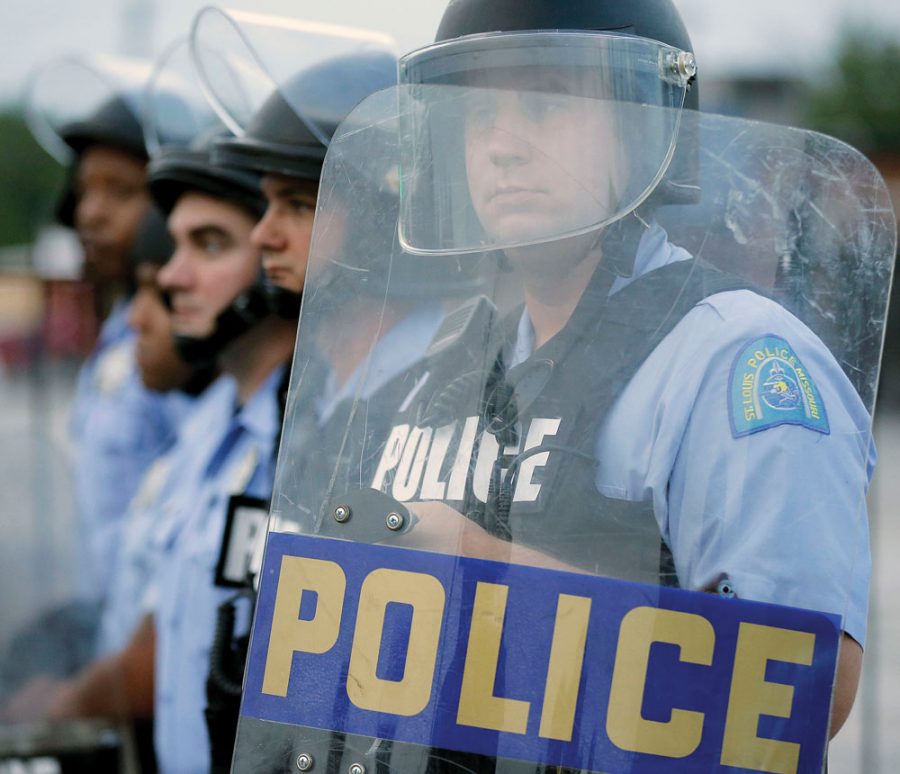Journalists often face-off against police forces
Out of 1,000 people polled, nearly 45 percent said they had a great deal of confidence in the police investigations that have taken place during the events of Ferguson, Mo., about 41 percent said they did not have much confidence, leaving 14 percent unsure, according to a recent survey by the Pew Research Center for the People and the Press.
Such results can raise many questions about how police investigate crimes in the community. However, even though the facts released by police were limited and the witness accounts about how Michael Brown was killed contradicted one another, people were still quick to form their own theories about the event and the investigations that occurred in the event.This led to a large amount of confusion surrounding the case in the weeks that followed, something that is seen in many instances when various media platforms become involved on police investigations.
Katherine Reed, associate professor of print and digital news at the University of Missouri, said Ferguson is just one of many cases in which the public has misinterpreted various facts of the investigation. Reed believes that many people point to social media as a incubator of false information.
“I think it’s Twitter. If the stories are not quite baked, so to speak, if there’s not enough information yet to know what’s happening, that can certainly scare people,” Reed said. “There’s…a lot of news being broken on Twitter, and there’s no context in Twitter– it’s only 140 characters. That’s… the challenge… [is] being careful about not putting information out… before you’re able to put it in context.”
Reed said she believes there is a social stigma surrounding journalists in police investigations and feels, contrary to the Hollywood stereotype that journalists are willing to cross boundaries in police investigations to get information, the media in her experience are working with the police and could even contribute to the investigation.

information source salon.com
Officer Latisha Stroer of the Columbia Police Department, however, disagrees. She said the media can push too far in an investigation, to the point where it can interfere with the police work.
“We put out a press release on major incidents that happen in the City of Columbia,” Stroer said. “What hurts an investigation is when [journalists] speak to people [when] we do not want certain information out so that we can investigate first and put out accurate information once that has been done.”
Despite the reasons that police officers may ask journalists not to release certain information, KOMU News Director Randy Reeves said he doesn’t believe certain facts should be kept from the public. Rather, he said journalists have a responsibility to the public. Reeves said in some situations he feels required to ignore those boundaries if he feels it is information necessary to keep people safe.
“If we find out something that we think is important and that the public should know, sometimes, the police would like to keep that quiet,” Reeves said. “They think that it would enhance their investigation to keep that quiet. I’m not saying that reporters don’t make mistakes… but I’d sleep very comfortably at night knowing that I’d given people at least some information so that they might be able to protect themselves.”
Reed, however, said the public can often misunderstand reporters’ intentions and wishes for people to understand their desires toward providing a voice for the community rather than working against the police.
“In all of the years I’ve been a journalist, I’ve rarely seen anyone step over police tape or…do anything sneaky to try and get information,” Reed said. “We really want to humanize the victim, and it’s hard to do that when you don’t have the information. Then it becomes all about the death, and not about the person’s life, and that’s not ideal. I don’t think that’s the best journalism.”
Overall, Stroer said she believes the media should strive for accuracy over speed in a breaking news story and should remain as neutral as they possibly can.
“Usually, people listen to the first thing put out instead of waiting for all of the facts,” Stroer said.
Reeves, however, feels that journalists have a responsibility to the public in releasing information that they uncover, even if police do not want that information released.
“I would say that sometimes there’s probably very little doubt that our mission and their mission don’t line up,” Reeves said. “Quite frankly, it’s our responsibility to report what’s going on. I’m sure there are times that our job and the nature of their job makes their job harder, and that’s just something that we always have to weigh out. We’re not on the same team.”
By Nicole SchroederPolice preparation: keep the safety on
Among the tools normally on the duty belt of a police officer, nestled in a tight holster is one weapon that with a clear shot, can end a life. Holding such a capacity to induce harm, extensive training for the use of firearms is only a logical demand.
“We are trained three times a year with our duty weapon,” RBHS Resource Officer Keisha Edwards said. “I’m also a rifle operator, and I am trained twice a year with a rifle. Those are eight hour days, sometimes three eight hours days [in a row].”
But after last year’s transition between two different brands of firearms—the Heckler and Koch handgun to the Glock handgun—Officer Edwards has trained more than 24 hours just this year, with training sessions split up into three eight-hour days. In those training sessions, officers learn how to operate, handle, clean and use the Glock. Included throughout all training sessions is the reinforcement of firearm safety.
“In the training, gun safety is a must. That’s one of the top priorities. We’re training eight hours a day, you want to first have safety,” Officer Edwards said. “One of the things I think we do best at the Columbia Police Department is constantly preach officer safety because that is first and foremost.”
At the University of Missouri-Columbia’s Law Enforcement Training Institute, firearm safety is a major component of the initial lesson.
“The first thing regarding firearms training that is taught are the fundamentals: safety, safety rules, stance, grip and presentation,” LETI seminar instructor Jason Sharp said.“This is done in the classroom and then we spend roughly three to four hours of dry fire exercises.”
With the requirement of at least 66 hours of firearm training, students attending LETI also learn about marksmanship, shooting stance, stress combat, firing at night and shooting decisions.
Along with learning about the physical aspect of firing a firearm, students are also schooled in the emotional facet of pulling a trigger.
“Day one of the Academy, we have a four hour block of ‘Officer Survival Mentality,” Sharp said. “This block of instruction covers a lot of the emotional and psychological aspects of law enforcement.”
Afterward, students learn to determine when it is and isn’t acceptable to use force with the study of constitutional and Missouri statutory laws. Following that lesson is an additional eight hours worth of training, meant to help students practice their judgement on the use of force.
“Requiring the officers to go through such intense training, perfect practice allows the actions to become muscle memory responses during, [what we refer to as,] combat stress. Beyond that, the officers need to make sure they can then live with their decisions for the rest of their life,” Sharp said. “The officer not only needs to be able to make the appropriate decision to use reasonable force, but they must also be able to write it right and say it right [in the report].”
As a longtime member of the Columbia Police Department, Officer Edwards’ training has been reinforced year after year, allowing her to be well-prepared in the face of an emergency.
“I’ve been a police officer for 13 years,” Officer Edwards said. “So two or three times [of training] a year for 13 years, it’s kind of stuck in your head of what to do and how to do it.”
This practice of post-academy training became common only after the 1980s, according to the Police Firearms Training Survey conducted by Gregory Morrison in 2008.
While law enforcement officers did take re-qualifying exams for their firearms, their training usually consisted of only a few practice shots at the department’s bull’s-eye target, inadequately preparing them for the use of their firearm in a dangerous situation.
“Training tends to be building blocks throughout the academy. What you learn on day one you must retain for the practicals in week 15,” Sharp said. “Each block builds on another, and it’s like a piece of the puzzle for the final product at the end.”
By Alice Yu
Racial profiling mixed with police work leads to persecution of minorities
“Ever since then, she just wants to get away.”
Two years ago, junior Milanne Bell-Fox was living in Hillsdale, a suburb in St. Louis County. She had grown up as an only child in a single mother, African American household, so the news that their family was about to get bigger with the addition of a baby brother was a change. When her mother was two months into the pregnancy, she was pulled over by the police for a license plate check.
“She’s a pregnant woman, and they stopped her, and she got out of the car,” Bell-Fox said. “And all of a sudden, from what she’s told me, they basically beat her up.”
Bell-Fox said her mother had a wrapped wrist because of chronic pain and had complained when the officers put handcuffs on her. According to Bell-Fox, her mother never filed a complaint with the authorities because she was scared of repercussions. Bell-Fox said her mother is still emotionally scarred from the incident.
“That was why we moved to Columbia,” Bell-Fox said. “Ever since then, she just wants to get away.”
Bell-Fox said this kind of behavior was not unusual for the police in her community, so she said the events that occurred in Ferugson did not surprise her. Bell-Fox has a personal connection to the situation, as the soft-spoken 16-year-old once walked down the same hallways as Michael Brown while both were students at Normandy High School.
In the wake of the situation in Ferguson, the attention on racial tensions in America ignited discourse on the issue of the “The Talk,” with hashtags such as #IGotTheTalk and “IGaveTheTalk” trending on Twitter in the weeks after Brown’s death.
The tweets referred to a tradition of African American parents speaking with their children regarding how to behave when police approach them.
Bell-Fox said her mother has given her a version of the “The Talk” her whole life.
“The talk goes back to all of those things, that the police will profile you,” Bell-Fox said. “So when you approach a police, the main thing my mom has taught me is to be respectful, and basically, kiss their butt.”
Although Bell-Fox’s mother has never gone to prison, many of her male relatives have spoken to her about their experiences with the American criminal justice system.
“I’ve gotten the talk from multiple family members, because a lot of the males in my family have been imprisoned for multiple years, and recently got out,” Bell-Fox said. “They talk about their experience in jail, and they say that police treat them like animals.”
There have long been accusations that police forces across the nation have structural bias against African Americans, particularly young black males. According to a study in the policy journal Crime and Delinquency, almost 50 percent of African American males will be arrested by age 23, as compared to 38 percent of whites.
For senior Haley Birk, these statistics do not present a convincing argument that police are biased against African Americans.
“I think race just happens to be a coincidence. Correlation does not prove causation,” Birk said. “You can’t prove police officers are racist just because more black people get put in jail.”
Though Birk, who is caucasian, concedes there may be individual officers who act with racial prejudice, she said police departments as a whole are not racist institutions.
“For the most part, police are just doing their jobs, and I don’t think there’s any issue with it,” Birk said.
Bell-Fox said while police officers have jobs to do, they are carrying them out incorrectly.
“I think the police, their job is to protect society, protect people,” Bell-Fox said. “And personally, I think one thing they do wrong is their approach because their approach may be based off of racial profiling.”
A report released by the Missouri Attorney General’s office in May brought renewed attention on the issue of police officers racially profiling black Missourians. The report revealed that there are high racial discrepancies in how police officers conduct routine traffic stops, with black drivers 66 percent more likely to be pulled over in comparison to white drivers.
This statistic is not surprising to junior Anthony Robinson. A young black male, Robinson has not personally dealt with police searches, but has had friends who have experienced this.
“There was this one friend that I had who lived in Kansas City as well. He got pulled over for I guess playing his music too loud, and it went on longer than it should,” Robinson said. “The cop should have just told him ‘Hey, turn your music down,’ but he searched his car. He didn’t have a warrant at all.”
Specific to the Columbia Police Department, the Attorney General’s report showed that of the cars Columbia Police Department officers stopped and searched, 13 percent belonged to black drivers, while three percent belonged to whites.
Officer Latisha Stroer said she would not comment on race relations in Ferguson, and did not respond to further questions about the 2014 traffic stop report.
Birk defended the Columbia Police Department by reiterating her belief that police departments are not racist institutions, and that race is not a factor in most police action.
“There are going to be police officers who are racist out there, but for the most part, they’re not going to discriminate just because of your race,” Birk said. “They’re more likely going to discriminate on the type of car you have.”
Eapen Thampy, the co-founder of the marijuana legislation reform association Show-Me Cannabis, views the report differently. He said America’s enactment of drug legislation is racially biased and creates these disparities.
“Drug prohibition has historically been a fundamentally racist exercise, as the prohibition of marijuana and cocaine are generally justified with a racist ideology,” Thampy said. “Law enforcement has huge incentives to arrest and incarcerate people and these efforts have affected and targeted racial minorities most severely.”
A 2009 Human Rights Watch report revealed that black Americans are arrested for drug offenses at three times the rate white Americans are, even though higher percentages of whites use illegal narcotics, as reported by a 2011 survey from the Substance Abuse and Mental Health Services Administration.

information sources civilrights.org and cnn.com
In Bell-Fox’s own experience, she said the use and peddling of narcotics by the African American community stems from the racially motivated obstacles black people face in life.
“[In the past] I’ve had to live in a house where drugs were sold, because that’s the only way to pay the bills, that’s the only way of living,” Bell-Fox said. “Say you’re a black teen.You can’t find a good job because of profiling, so you sell drugs, and then you go to prison and when you get out you can’t get a job because this is on your record. What am I going to do? I’ll sell drugs. It’s a cycle.”
Bell-Fox had a final message for the nearly 800,000 police officers in the United States.
“Besides looking at African Americans as targets, look at them as people, treat them as people,” Bell-Fox said. “Approach them different and treat them as equally as any other race, not less.”
By Jenna LiuHave you or a friend been affected negatively by racial profiling? Do you feel racial profiling is still prevalent in America? How can it be curbed?Do you think journalists over step their boundaries, or are their actions justified? How satisfied are you with the police work conducted in Ferguson?
Do you think police are adequately trained in Columbia?


















































































